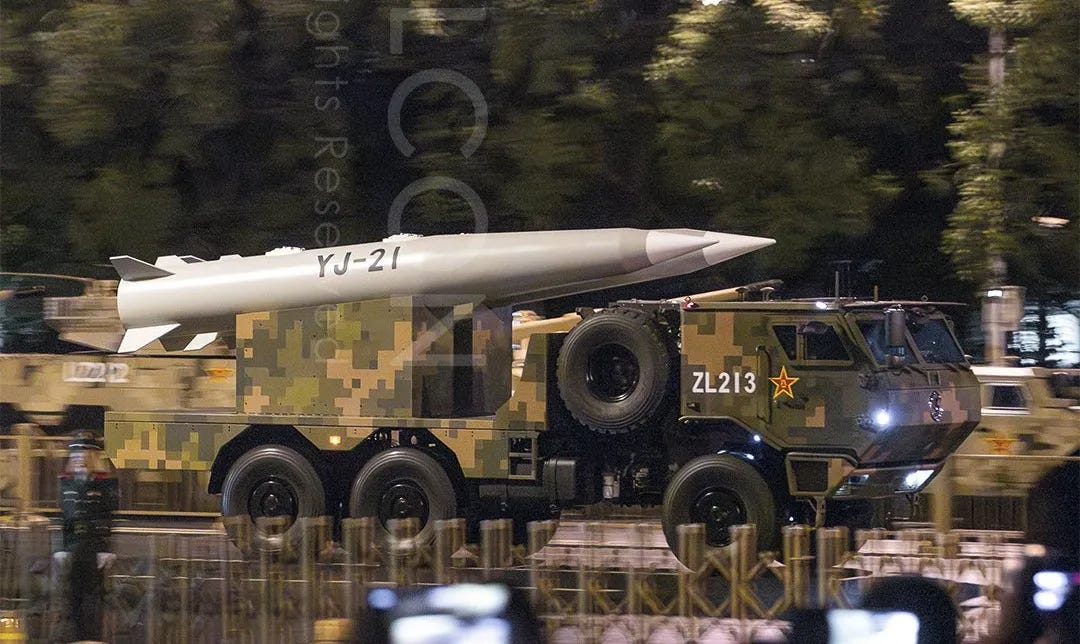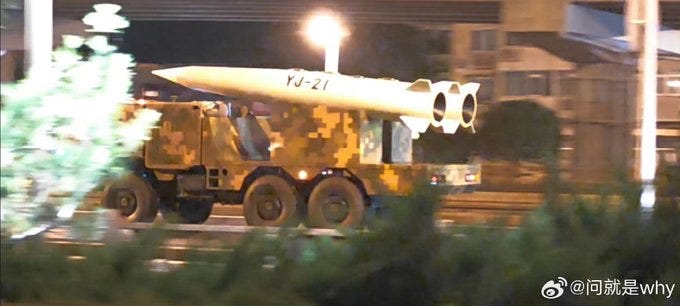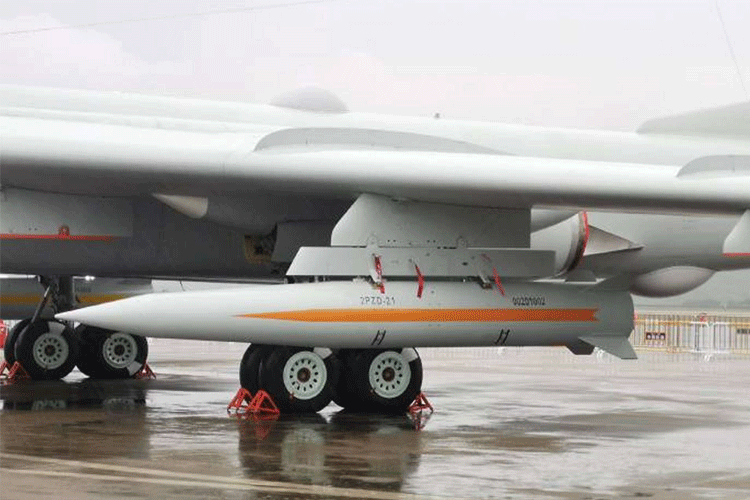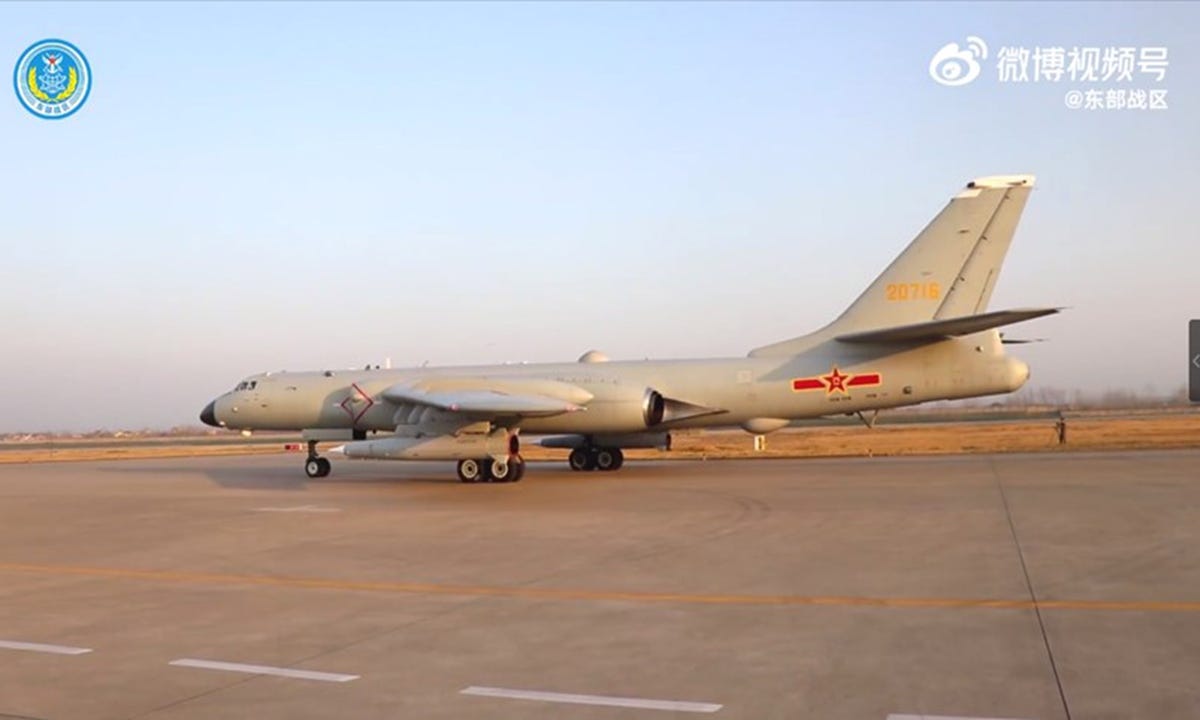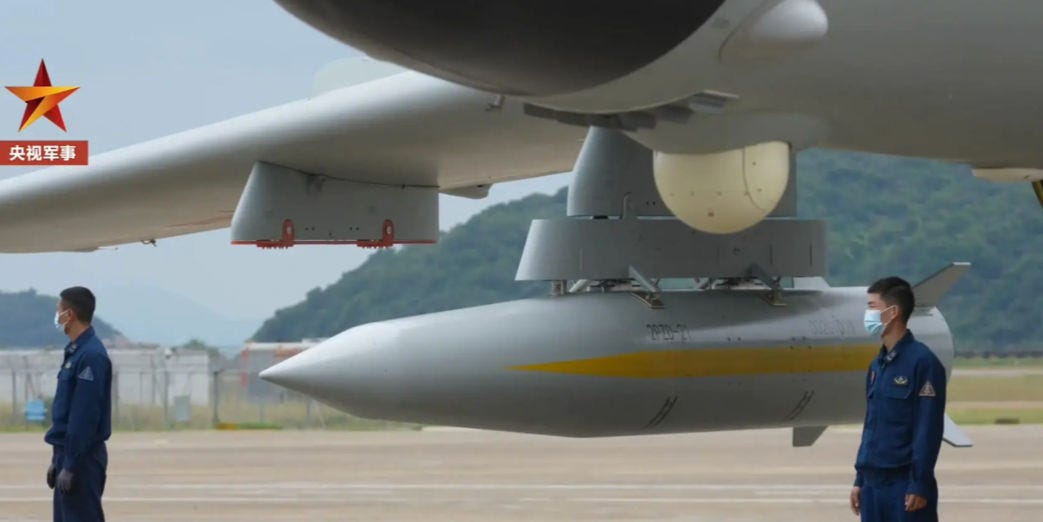Note: The following text was originally posted on my X/Twitter account.
One of the missiles that will feature in the forthcoming military parade in Beijing is the YJ-21 air-launched ballistic missile. The presence of a pair of attachment points—heavy-duty "suspension lugs"—indicates that this is an air-launched design, given that no such attachment points are required for a ground-launched ballistic missile design. The use of the YJ- designation prefix indicates that the YJ-21 is an air-launched anti-ship ballistic missile.
The YJ-21 is one of several munitions that are set to feature in the forthcoming 3 September military parade in Beijing that can be said to have been "miscategorized." The truck on which two YJ-21 mockups—it is unsafe to parade a fully fuelled and armed missile at such a major public event attended by political and military leaders—is marked with a designation that begins with the ZL- prefix, which denotes strategic strike module. As with what now appears to be a new anti-ship cruise missile bearing the designation YJ-18C, the YJ-21 air-launched ballistic missile is being displayed alongside the People's Liberation Army Rocket Force's (PLARF) ground-launched nuclear- and "conventionally"-armed ballistic and cruise missiles as well as the People's Liberation Army Navy's (PLAN) nuclear-armed submarine-launched ballistic missiles. The parade rehearsals indicate that there will be a large ground display, including missile mockups, with trucks bearing the HZ- prefix, which denotes maritime operations module. This notably includes trucks that are carrying mockups of the new YJ-15, YJ-17, YJ-19, and YJ-20 anti-ship missiles. As with the new YJ-18C anti-ship cruise missile, it is unclear why the YJ-21 air-launched anti-ship ballistic missile is being displayed alongside the PLARF's highly specialized missiles and the PLAN's nuclear-armed submarine-launched ballistic missiles.
Although the forthcoming parade will be the first (formal) public event at which the YJ-21 designation will be publicly seen, it is important to note that the YJ-21 is likely to be the same air-launched ballistic missile design that was formally but very quietly unveiled at the 2022 Zhuhai Airshow. The YJ-21 notably also appeared in officially released media from a military exercise held around the island of Taiwan in early April 2025.
The YJ-21 is associated with the PLA Air Force's (PLAAF) H-6K bombers, but it may also be used with the PLAAF's (ex-PLAN Air Force/PLANAF) H-6J bombers as well as the PLAAF's reportedly nuclear-armed and aerial refuelling-capable H-6N bombers. While the YJ-21 is far too large and heavy to be carried by the PLAAF's non-bomber aircraft, Chinese industry appears to have developed a smaller and lighter air-launched ballistic missile design of uncertain designation that may come to be carried by the likes of the J-16 fighter.
One curious dynamic related to the YJ-21 is how it was first unveiled alongside a PLAAF H-6K bomber at the 2022 Zhuhai Airshow. In 2023, the PLANAF transferred most of its land-based crewed fixed-wing combat aircraft to the PLAAF, which essentially resulted in the PLAAF monopolizing the aerial maritime strike mission. Prior to the mid-2010s, most PLAAF combat aircraft units had very limited experience with operating over open water. The presence of what we now know as the YJ-21 air-launched ballistic missile—specifically, an inert training version—under the wings of a PLAAF H-6K bomber amounts to a small but interesting data point as to how the PLAAF was making concerted efforts to expand the maritime strike capabilities of its bomber force long before the PLANAF transferred its H-6J bombers—which amount to a variant of the PLAAF's H-6K—as well as its older H-6L (upgraded H-6G) bombers to the PLAAF in 2023. The YJ-21 integration onto the PLAAF's H-6K bombers data point should be viewed alongside the integration of the ramjet-powered YJ-12 supersonic anti-ship cruise missile with the PLAAF's H-6K bombers, which was documented ca. 2020. Prior to that time frame, the YJ-12 supersonic anti-ship cruise missile was almost exclusively associated with the PLANAF's much smaller fleet of H-6J bombers, a then underappreciated dynamic that logically limited the net implications of the air-launched YJ-12 independent of its qualitative attributes.
It is possible, even likely, that the YJ-21 designation refers to the anti-ship version warranting the YJ- designation prefix—the YJ-21 likely features an active radar homing seeker—of an air-launched ballistic missile design that primarily exists to strike stationary terrestrial targets. Should such a non-anti-ship version exist, it will likely have a different designation prefix, either KD-21 or KF-21.
For background on what was publicly known about Chinese air-launched ballistic missiles through late March 2025 and the history of this peculiar type of munition more generally, visit the following link:
Chinese Air-Launched Ballistic Missiles
The PLAAF in general and the PLAAF bomber fleet in particular require long-range standoff munitions to practically undertake attacks against distant heavily defended targets. Very long-range standoff munitions can more generally extend the reach of the PLAAF and thereby allow the PLAAF to substantially bolster the long-range strike capabilities resident…


